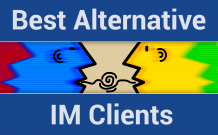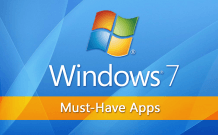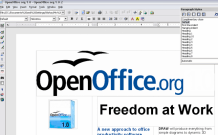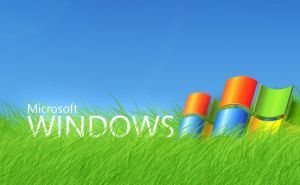Kids love dinosaurs. It's amazing how accurately four-year boys pronounce the names of the long extinct saurians, like 'triceratops' or 'stegosaurus', whereas some of my college mates are by far not that good at coping with that linguistic challenge. Kids watch Jurassic Park again and again, collect loads of pictures with the giant reptilians and lead prolonged quasi-scientific discussion with each other as to which dinosaur is cooler, tyrannosaur or velociraptor.
The funny thing is that when we grow up, we go on nurturing the fondness for big logy things, maladapted for the life in the 21st century. What changes is just the object of our affection, as we stop loving big lizards and get to love the computer caboodle. Windows is one of the prime examples of those 'IT-dinosaurs': it's sluggish, it's prone to attacks, it seems to be designed for a nerdy geek rather than a general user. Still, all these drawbacks do not prevent the overwhelming majority of users around the world from using the Windows OS. (However, the upcoming release of Windows 8 can do justice to such persistence, since Microsoft seems to have waved good-bye to most of the Windows obsolete features in the new Metro UI.)
Another software saurian we love to see on our hard drives is the Portable Document Format, better known as PDF. This format was introduced by Adobe Systems back in 1993 (yeah, if it were a human being, it could buy beer in Manitoba by now). Since that time the PDF saw only a handful of changes: the major ones being the support for graphical transparency, i.e. that funny white-gray background, external links, and usage rights signatures. The most significant change to the format was, perhaps, its release as an open standard in 2008, when Adobe finally gave up on prosecuting pirate software developers. Prior to that year, you could get into some serious trouble for running PDF not in Adobe Reader.
As of 2011, PDF has practically become the standard for the web documents; the fact that this very formay was chosen as the standard one flabbergasts me not less than the kids knowing the roots of paleontology in the age of five. Sounds ungrounded? Okay, let's see, what PDF really is.
The Adobe PDF Reference describes the format as 'representing documents in a manner independent of the application software, hardware, and operating system used to create them and of the output device on which they are to be displayed or printed.' In layman's terms, it means that PDF documents will look the same wherever you open them. Windows, Mac, Linux, Android, some obscure Chinese iOS-clone, assembled with the programmers' eyes shut: it doesn't matter, the PDF documents will be displayed in the same way, as long as the OS supports the format.
How does it do it? The secret is all too obvious: the entire information about the file lay-out gets encapsulated in the PDF-file, including the text, graphics, fonts, tables, etc. The snag is that, once encapsulated, this information is impossible to extract. Put simply, there isn't really a way to edit a PDF file, unless you haven't bought Adobe Acrobat Pro from Adobe for a modest sum of $US 499 . There is no other way. Absolutely.
When I heard about it for the first time, I was literally stunned. Imagine that you can't delete a single full stop, a single comma, a single wretched space in a PDF-document, unless you buy! This howling shame wouldn't fit in my mind, and I spent half of my weekend trying to find some decent free PDF-editor.
The first program I could grab is called Enfocus Browser. I got it onto my computer as soon as I read the magic word 'free' in the program description and hoped it would solve all my problems, but I was cruelly misguided.
After clicking the installed program's shortcut, I saw a weird splashscreen with a cute elf and had to tell myself: 'Don't worry, this thing is freeware, keep it in mind...'
But all my hopes got ruined as Browser's Control Panel opened.
Enfocus Browser Application: The Weird Splashcreen and Spartan Interface
I desperately started looking for something that would distantly resemble tools for editing as we know them from Microsoft Office and the like, but all my efforts were a waste of time. Instead I got a pile of mysterious 'PDF Objects', the elements of the PDF-document low-level structure. Actually, for a person who knows a lot about the PDF low-level structure this program might be really useful, but how many people have ever just heard about it? I venture to suggest, the numbers won't be that high.
Enfocus Browser Application: As Easy as a Pie
I think there's no need to say, Enfocus Browser went to the recycle bin immediately . However, if you are not so obsessed with freebies as I am, you can give Enfocus one more chance and purchase its editing plug-in for Adobe Acrobat, Enfocus PitStop. I cannot say anything bad about this program for one reason only: I haven't tried it, even though there is a trial version; I don't need any highly truncated trial of a 699 dollars plug-in for a 499 dollars program.
The next item on my list was PDFEditor by a certain software enthusiast Eva Peskova. This program does way better than Enfocus Browser: it features a sleek interface, has a comfortably small size, and... and that's it. Maybe it's the absence of any help or manual, maybe something else, but when I tried to edit some file text there, I failed:
PDFEditor: The Results Were Not as Brilliant as I Had Hoped
Of course, it can be my lack of experience that is to blame for my failure, but I don't think it is the reason. PDFEditor does not look like software with lots of features, concealed from the n00b's eye. Then only the program itself is left...
The third application I tried was Inkscape. This program is basically the vector graphics manager and is suitable for editing PDF but only when used with Poppler, a free-software library for rendering files of this tricky format. Even so, Inkscape has been the the undisputed winner in my little free PDF-editors race.
Inkscape: The Best What I’ve Been Able to Find
At first blush, the results of my editing activity were less than unimpressive, and they really were so. The disorderly pile of letters and other characters does not look much like a neat text I had hoped to get as the output. Nevertheless, I must admit that Inkscape sometimes does work; it really inserts the typed letters there, where we want them inserted, and at the same time complies with the font, size, and other parameters of the insertion environment. Another thing is that more than often the program doesn't work properly, which leads to the chaos we see on the picture above, and you never know, if you are lucky enough to see it functioning rightly. Apparently, the secret lies in the notorious low-level structure of PDF, but that is no roost I'd dare to rule without profound knowledge of the subject.
Let's summarize: the three freeware programs we have checked out have proven to be a complete failure when it comes to serious editing of the PDF files. The only piece of software that seems to do this job more or less good is the commercial Adobe Acrobat, which costs half a thousand bucks (Enfocus plug-in does not count, as I have never heard about anyone using it).
That's an off-the-wall instance in the history of software: the text file format has been an open standard for more than three years and there are still no programs for editing files in it. That's a bad strategy of survival in these fast-moving times...
Do you still think PDF has nothing in common with the dinosaurs?



















Comments